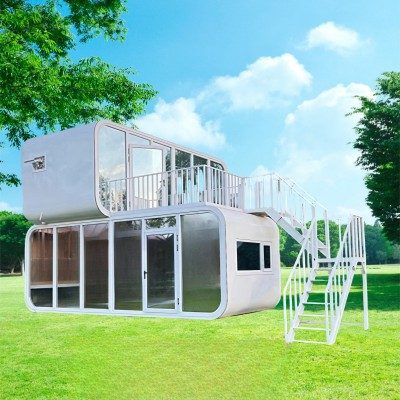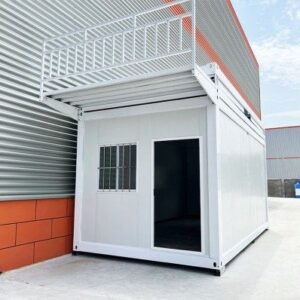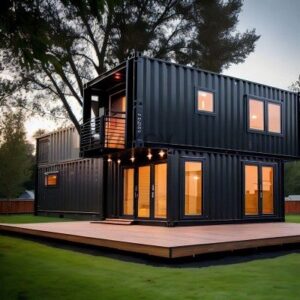How much do container houses cost On average, a standard container home typically ranges between $30,000 and $100,000 depending on size, type, and location. This price usually covers the basic shell—that is, the container itself plus some initial modifications.
Base Price Range for Standard Container Houses
- Single 20-foot container home: Around $20,000 to $40,000
- Single 40-foot container home: Roughly $35,000 to $60,000
- Multiple container homes or larger custom builds: From $70,000 up to $150,000 or more
Prices vary mainly due to the number of containers used and the extent of customization.
Price Differences Based on Size Type and Location
- Size and layout: Bigger or multi-container homes cost more due to added materials and labor.
- Type: Basic shell vs. fully finished modular homes. Shell-only costs less, while turnkey homes with interior finishes push prices higher.
- Location: Urban areas or regions with high labor costs can add 10%–20% to the total cost. Remote or hard-to-reach sites may increase shipping and permit fees, raising costs further.
Container Home vs Traditional Home Building Costs
Building a container house often costs 20% to 40% less than traditional houses, depending on design complexity and materials. Traditional construction averages around $150 to $200+ per square foot, whereas container homes frequently fall between $100 and $150 per square foot.
| Cost Aspect | Container House Estimate | Traditional Home Estimate |
|---|---|---|
| Price per Square Foot | $100 – $150 | $150 – $200+ |
| Construction Time | 2 – 6 months | 6 – 12 months |
| Labor Costs | Lower (can DIY or small teams) | Higher due to specialized trades |
| Material Costs | Steel reuse possible lowers cost | Standard construction materials |
Overall, container homes offer a competitive, often more affordable alternative, especially for those looking for quicker builds and smaller footprints.
Detailed Cost Breakdown of Building a Container House
When figuring out how much do container houses cost, it’s important to look beyond the sticker price of the container itself. Here’s a clear breakdown of the major expenses involved in container house construction.
Purchase price of shipping containers new vs used
- New containers typically run between $3,000 and $5,000 for a standard 40-foot unit. They’re in great shape but pricier upfront.
- Used containers can cost as little as $1,500 to $3,000, but expect some wear and needed repairs.
- Choosing new or used affects your initial investment and sometimes your renovation work.
Construction and modification expenses
Turning a shipping container into livable space means cutting, welding, and reinforcing. These modifications usually run about $10,000 to $30,000 depending on how much structural work is needed.
Interior fittings and finishes plumbing electrical insulation
- Plumbing and electrical installations can range between $5,000 and $15,000 based on system complexity and local codes.
- Insulation is crucial for comfort and energy efficiency; costs vary widely but expect around $2,000 to $6,000.
- Interior finishes (flooring, walls, cabinetry) add another $10,000 to $25,000 depending on quality and style.
Foundation and site preparation costs
Even container homes need a solid foundation, which can cost from $3,000 to $10,000—this depends on soil type and local site conditions like grading and drainage.
Labor costs DIY vs hired contractors
- Doing most work yourself can save substantial money but requires time and skill.
- Hiring contractors increases costs; labor can add 20-40% to your budget. Always factor this in to avoid surprises.
Permits fees and legal considerations
Before building, you’ll need to secure permits and pass inspections. Permit fees vary by city and usually range between $500 and $2,000. Navigating zoning and building codes can also add indirect costs if modifications or delays arise.
If you’ve ever wondered how much do container houses cost, you’re not alone. Container homes are shaking up the housing market with their unique design and affordability—but nailing down the true price can be tricky. From shipping container purchase to construction, customization, and hidden fees, there’s a lot to consider before you invest. In this guide, you’ll get a clear, no-fluff breakdown of container house construction cost and everything that influences your budget. Ready to see if a container home is the right—and affordable—choice for you? Let’s get into it.
What is a Container House Definition and Types
A container house is a living space made by converting shipping containers into functional homes. These homes utilize steel freight containers, which are repurposed to serve as durable and affordable building blocks. Container houses come in several types depending on design and construction:
- Single-container homes: Simple, compact units ideal for tiny homes or guest houses.
- Multi-container homes: Multiple containers combined to create larger layouts with several rooms.
- Stacked or modular container homes: Containers stacked vertically or horizontally for multi-story designs.
- Hybrid container homes: Containers integrated with traditional building materials like wood or concrete for added design flexibility.
Common Uses of Container Houses
Container houses are popular for various purposes beyond just permanent living. They are often used for:
- Affordable primary residences or tiny homes
- Vacation cabins and weekend getaways
- Office spaces, studios, or workshops
- Emergency housing and disaster relief shelters
- Accessory dwelling units (ADUs) or rental units
Benefits of Container Houses Impacting Costs
Several advantages affect the overall cost and appeal of container homes:
- Lower material costs: Using recycled or new shipping containers often makes the base structure less expensive than traditional construction.
- Faster build times: Pre-formed steel structures speed up construction, reducing labor costs.
- Strength and durability: Shipping containers are built to withstand tough conditions, which means reduced maintenance and longer lifespan.
- Flexibility in design: Containers can be modified and combined in many configurations, impacting costs based on complexity.
- Eco-friendly options: Many choose container homes for their sustainability benefits, which can also lower utility costs if energy-efficient materials and appliances are used.
Understanding what a container house is and the types available provides a foundation for estimating the container home price breakdown and useful insights into why these homes present an appealing, often cost-effective alternative to traditional housing.
Factors That Influence Container House Costs
When figuring out the cost to build a container house, several key factors come into play that can either raise or lower your overall budget. Understanding these helps you plan better and avoid surprises.
Location and Accessibility Impact on Container Home Costs
Where you build greatly affects expenses. Remote or hard-to-reach sites can increase transportation and labor costs. Urban areas might have higher permit fees but easier access to materials. Additionally, regional factors like local building codes and climate influence construction methods and price.
Design Complexity and Customization Price Variations
Simple, boxy designs typically cost less, while customized layouts with multiple containers or unusual shapes add to the price. Features like additional windows, doors, skylights, or rooftop decks require more labor and materials, pushing up the container house construction cost.
Quality of Materials and Appliances Influencing Costs
The choice between budget-friendly and premium materials makes a significant difference. High-end finishes, energy-efficient windows, and modern appliances can considerably increase costs compared to basic options but can also add value and comfort long-term.
Energy Efficiency and Sustainability Features Cost Effects
Incorporating insulation, solar panels, rainwater systems, or green roofs tends to increase upfront costs but leads to savings over time through lower utility bills. These sustainable upgrades can impact your container home price breakdown but enhance environmental benefits and resale value.
Shipping and Transportation Expenses
Shipping containers vary in cost depending on size, condition, and where they come from. Transporting containers to your site, especially if it’s remote, adds shipping container home costs beyond the container price itself. Heavy equipment access and special delivery needs can push construction costs higher.
By keeping these factors in mind, you can get a clearer picture of what influences your container house cost and how to manage your budget without compromising your dream home’s quality or style.
Cost Saving Tips for Container Houses
When looking to lower the container house construction cost, there are several smart ways to save without cutting corners on quality or comfort.
Choose the Right Container Size and Condition
- Pick the right size to match your needs—smaller homes with fewer containers cost less upfront and reduce modification expenses.
- Consider buying used shipping containers in good condition; they’re often cheaper than new ones, but always check for rust or structural damage that could cost more to fix later.
Simplify Your Design Without Sacrificing Quality
- Avoid overly complex or custom designs—keeping layouts straightforward reduces labor and material costs.
- Stick to standard container dimensions to make construction smoother and cut down on expensive alterations.
Use Recycled or Affordable Materials
- Incorporate recycled materials for interior finishes like flooring, cabinetry, or insulation to save on supply costs.
- Opt for cost-effective alternatives that meet safety and quality standards, such as foam insulation instead of expensive spray foam, or laminate countertops instead of stone.
Balance DIY Elements with Professional Help
- Take on DIY projects like painting, basic interior work, or landscaping to cut down on labor costs.
- Hire professionals for critical tasks like structural modifications, plumbing, and electrical work to avoid costly mistakes and ensure your container home is safe and code-compliant.
By focusing on these tips, you can effectively reduce your overall container home price breakdown without sacrificing durability or comfort.
Hidden and Additional Costs to Watch For in Container House Construction
When figuring out container house construction costs, it’s easy to focus on the obvious expenses like materials and labor. However, several hidden and additional costs often catch buyers off guard. Being aware of these can save you from unexpected bills down the line.
Unexpected Site Conditions and Preparation Costs
One of the biggest surprises comes from site conditions. The soil quality, ground stability, and local weather can all impact the work needed to prepare your land for a container home.
- Poor soil quality may require extra foundation work or soil replacement.
- Sloped or uneven land can increase grading costs.
- Weather-related delays—especially in areas with heavy rain or snow—can extend your construction timeline and add labor expenses.
- Accessibility issues also play a role; remote locations might increase delivery and transportation fees for containers and materials.
Regular Maintenance and Repair Costs
Container houses might be durable, but they’re not maintenance-free. Rust prevention, especially in humid or coastal climates, is crucial to protect the steel containers and keep repair expenses low.
- Inspecting and resealing seams and coatings every few years is necessary.
- You may face upkeep costs distinct from traditional homes, like specialized paint or corrosion treatments.
- Repairs involving structural elements or custom modifications can be pricier since they require specific skills.
Insurance and Property Taxes
Don’t overlook insurance and property tax costs, which can differ significantly between container homes and traditional houses depending on your location.
- Some insurers might charge higher premiums due to the unconventional construction.
- Property tax assessments can vary based on the appraised value of your container home, which might be harder to estimate initially.
- Check local regulations early to understand how your container house will be classified for tax purposes, as this affects your long-term costs.
By planning for these hidden expenses and ongoing costs, you’ll get a more realistic picture of the true investment required for your container house—helping you budget smarter and avoid surprises.
Financing and ROI for Container Houses
Financing Options for Container Homes
When it comes to financing container houses, traditional mortgage lenders can be hesitant because container homes are still seen as non-standard builds. However, there are several financing routes available:
- Personal loans and home improvement loans: Often easier to get but may come with higher interest rates.
- Construction loans: Some lenders offer loans specifically for container home construction, especially if you work with a licensed builder.
- FHA and VA loans: Limited availability, usually only if the container home meets local zoning and building codes.
- VA loan alternatives and private lenders: These may offer more flexible terms but require good credit.
- Owner financing or crowdfunding: Sometimes considered for custom builds or off-grid locations.
It’s important to have detailed cost estimates and plans ready to improve your chances of approval.
Resale Value and Long Term Investment Potential
Resale value for container homes varies depending on location, build quality, and market demand. In areas where affordable and sustainable housing is in demand, container homes are gaining popularity. However, some buyers still prefer traditional homes, which can affect resale price.
Key points about container home ROI:
- Lower initial investment compared to traditional homes can mean a faster return.
- Reduced utility costs thanks to energy-efficient designs boost long-term savings.
- Customization and quality builds increase desirability and resale potential.
- Zoning and neighborhood acceptance heavily influence market value.
Overall, a well-planned container house can be a smart investment, especially in markets open to alternative housing.
Environmental and Lifestyle Benefits
One major advantage boosting the container house ROI is the environmental and lifestyle benefits:
- Sustainability: Reusing shipping containers lowers material waste.
- Energy efficiency: Proper insulation and solar options reduce utility bills.
- Smaller footprint: Encourages minimalist living and simplifies upkeep.
- Faster construction time means you start saving on housing costs sooner.
These factors often translate into financial benefits over time, making container houses a sensible choice for eco-conscious and cost-aware buyers in the U.S. market.
Why Choose Yichen for Your Container House Cost and Build
When considering how much do container houses cost, choosing the right company is crucial. At Yichen, we bring expertise and transparent pricing models that help you understand every dollar spent on your container home project. We don’t just offer a price; we break down the container house construction cost so you can see exactly where your investment goes.
Transparent Pricing and Clear Cost Breakdown
One of Yichen’s strengths is clear, upfront pricing with no hidden fees. Whether it’s for a 20-foot container tiny house or a fully customized expandable container house, we provide detailed estimates covering:
- Container purchase and condition (new vs used)
- Construction and modification expenses
- Interior fittings, plumbing, and electrical work
- Foundation and site prep costs
- Labor charges
This approach eliminates surprises and helps you manage your budget effectively.
Wide Range of Customization Options
The cost of a container house can vary based on design and materials, and Yichen offers plenty of customization without inflating your price. From compact affordable container homes to luxury options with energy-efficient features, you can tailor your project based on your needs and budget.
Check our 20ft Single Container House or the Expandable Container House to see popular designs that balance cost and comfort.

Proven Quality Assurance and Ongoing Support
The quality of materials and workmanship directly affects container home prices long-term. Yichen guarantees high-quality standards in every build—from structural integrity to finishes. Our expert team supports you at every step—design, construction, permits, and aftercare.
We also provide guidance on cost-saving options without sacrificing quality, helping you get the best value for your investment.
Customer Satisfaction Through Real Testimonials
Don’t just take our word for it—Yichen clients praise our transparency and professionalism. Customer testimonials reflect how we keep the container home price breakdown clear and the process smooth, easing concerns about financing and unexpected costs.
Explore more about why Yichen is a trusted name in the US container housing market on our About page



